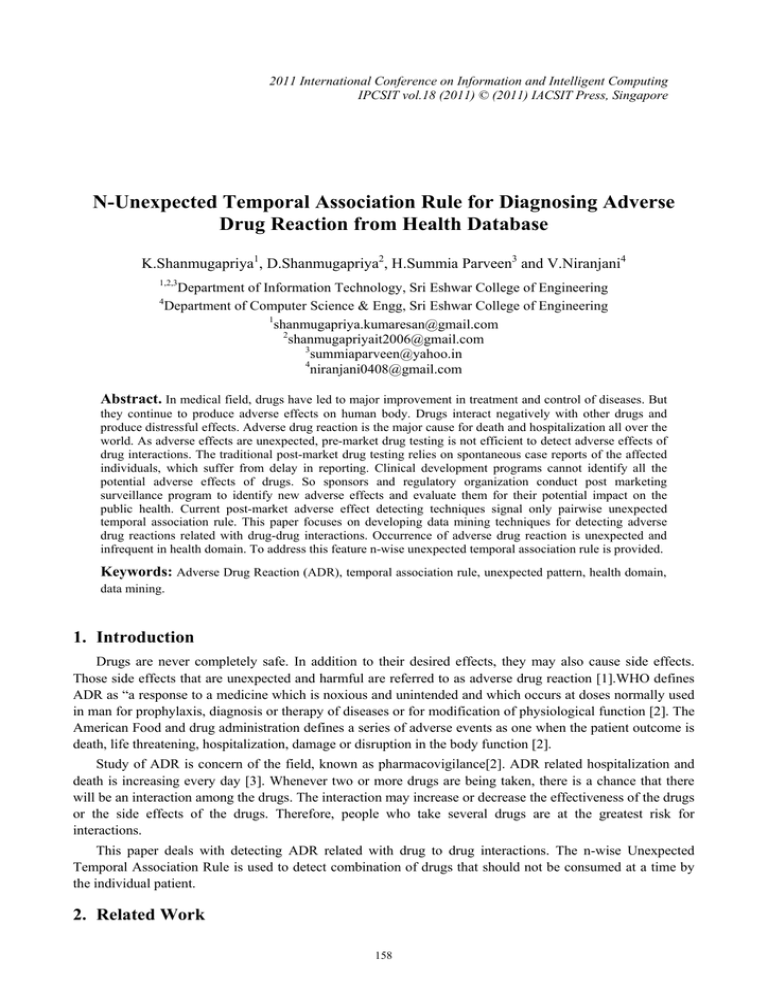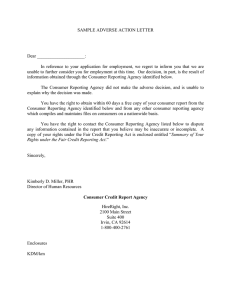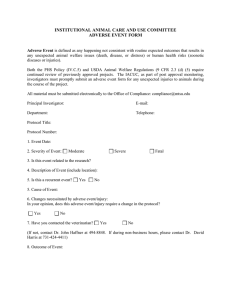N-Unexpected Temporal Association Rule for Diagnosing Adverse K.Shanmugapriya , D.Shanmugapriya
advertisement

2011 International Conference on Information and Intelligent Computing
IPCSIT vol.18 (2011) © (2011) IACSIT Press, Singapore
N-Unexpected Temporal Association Rule for Diagnosing Adverse
Drug Reaction from Health Database
K.Shanmugapriya1, D.Shanmugapriya2, H.Summia Parveen3 and V.Niranjani4
1,2,3
4
Department of Information Technology, Sri Eshwar College of Engineering
Department of Computer Science & Engg, Sri Eshwar College of Engineering
1
shanmugapriya.kumaresan@gmail.com
2
shanmugapriyait2006@gmail.com
3
summiaparveen@yahoo.in
4
niranjani0408@gmail.com
Abstract. In medical field, drugs have led to major improvement in treatment and control of diseases. But
they continue to produce adverse effects on human body. Drugs interact negatively with other drugs and
produce distressful effects. Adverse drug reaction is the major cause for death and hospitalization all over the
world. As adverse effects are unexpected, pre-market drug testing is not efficient to detect adverse effects of
drug interactions. The traditional post-market drug testing relies on spontaneous case reports of the affected
individuals, which suffer from delay in reporting. Clinical development programs cannot identify all the
potential adverse effects of drugs. So sponsors and regulatory organization conduct post marketing
surveillance program to identify new adverse effects and evaluate them for their potential impact on the
public health. Current post-market adverse effect detecting techniques signal only pairwise unexpected
temporal association rule. This paper focuses on developing data mining techniques for detecting adverse
drug reactions related with drug-drug interactions. Occurrence of adverse drug reaction is unexpected and
infrequent in health domain. To address this feature n-wise unexpected temporal association rule is provided.
Keywords: Adverse Drug Reaction (ADR), temporal association rule, unexpected pattern, health domain,
data mining.
1. Introduction
Drugs are never completely safe. In addition to their desired effects, they may also cause side effects.
Those side effects that are unexpected and harmful are referred to as adverse drug reaction [1].WHO defines
ADR as “a response to a medicine which is noxious and unintended and which occurs at doses normally used
in man for prophylaxis, diagnosis or therapy of diseases or for modification of physiological function [2]. The
American Food and drug administration defines a series of adverse events as one when the patient outcome is
death, life threatening, hospitalization, damage or disruption in the body function [2].
Study of ADR is concern of the field, known as pharmacovigilance[2]. ADR related hospitalization and
death is increasing every day [3]. Whenever two or more drugs are being taken, there is a chance that there
will be an interaction among the drugs. The interaction may increase or decrease the effectiveness of the drugs
or the side effects of the drugs. Therefore, people who take several drugs are at the greatest risk for
interactions.
This paper deals with detecting ADR related with drug to drug interactions. The n-wise Unexpected
Temporal Association Rule is used to detect combination of drugs that should not be consumed at a time by
the individual patient.
2. Related Work
158
This paper is concerned with the problem of mining drug to drug interactions that may cause adverse
effects. In [4], Spontaneous case reports were used to mine the ADR. In [5], [6] UTAR was used to mine drug
specific ADR signals from administrative health databases. [6], [7] explored pairwise UTAR.
It has been noted in [8] that objective measures are not sufficient for determining the interestingness of the
discovered patterns. Subjective measures are needed. Two main subjective measures are unexpectedness and
actionability. The post market ADR detection technique like Bayesian data mining technique [10] perform on
spontaneous case reports which describes the suspected causality between drugs and adverse effect for one
patient. Spontaneous case reports suffered from underreporting and delay. This work aims to highlight the
problem of mining n-wise UTAR where antecedents and consequents occur together unexpectedly.
3. Background Study
3.1. Association Rule
Let I={x1, x2, x3….xm} be a set of items. Let the set X be a subset of I. k=|X| is called k-item set. Let
database D be a set of transactions where each transaction T is a set of items such that T is a subset of I. A
transaction T is said to support X if and only if X is a subset of T.
Association rule is an implication of the form X=>Y, meaning that the presence of the set X implies the
presence of another set Y, where X is a subset of I, Y is a subset of I and X. This rule X=>Y holds in the
transaction set D with confidence of c if c% transaction in D that contain X also contain Y. This rule X=>Y
has support in the transaction set D if s% of transaction in D contains X.
3.2. Unexpected Pattern
Patterns are unexpected if they are previously unknown to the user [8]. Unexpected patterns are, by
definition, interesting. Unexpected patterns include:
1. Unexpected consequent
2. Unexpected reason
3. Totally unexpected pattern
3.3. Temporal association rule
Temporal association rule [6], [11] is denoted as A→C with respect to T, where A is the antecedent, C is
the consequent and T is the time window of length T. A and C are constrained within T.
3.4. Unexpected temporal association rule
UTAR is denoted by A→C with respect to T, where the consequent C occurs unexpectedly within a T size
period after the antecedent A. The support of the UTAR, supp (A→C with respect to T), is the proportion of
T-constrained subsequences that unexpectedly contain A followed by C among all of the T-constrained
subsequences. Its confidence is given by conf (A→C with respect to T) = supp (A→C with respect to T)/supp
(A→with respect to T), where supp (A→with respect to T) is the proportion of T constrained subsequences
that unexpectedly contain A.
3.5.
Drug Interactions
Drug interactions may make the drug less effective, cause unexpected side effects, or increase the action
of a particular drug. Some drug interactions can even be harmful causing death or disability of the organs of
human body. Drug interactions fall in 3 broad categories.
1. Drug-drug interaction
2. Drug-food interaction
3. Drug-condition interaction
4. Proposed System
4.1. Algorithm
1. Initialize Antecedent list Ai (i=1,2,…,n) and Consequent list C(d1,d2…dm),time periods study period Ts,
159
2.
control period Tc, hazard period Th ,output setA ,setC, number k.
Initialize each A along with its ingredient as
n
m
∑ (∑)
A=0 l=0
3. For each Ai generate the ingredient list Ii (i=1, 2,…,n and side effect list Cj(j=1,2,..,m).
4. Calculate leverage l as
I(A(I1,I2,...,In))=supp(A(I1,I2,...,In)→C(d1,d2,..,d m)) with respect to T,where supp denotes minimum
support.
5. Rank the leverage and store top k consequents in setC.
6. For each Consequent listed in set C find the case sequence and non case sequence.
7. Calculate the residual leverage rl as
rl(A(I1,I2,…,In)→C(d1,d2,...,dm))=
supp((A(I1,I2,...,In)→C(d1,d2,...,dm))-supp
(A(I1,I2,...,In))*supp(→C(d1,d2,…,dm)) with respect to T.
8. Rank top k rl and store in seta.
9. Compare setC with seta.
10. If A (I1, I2,…,In) in set C is also present in setA then output the top k ingredients.
11. Compare the ranked ingredients with patient data and then rank.
12. Output the top k adverse drug combinations.
4.2. System architecture
Figure 1.
Adverse Drug Combination Detecting System
Fig 1. shows the architecture of the system that is used to detect adverse drug combination. The Drug
sequence and ingredient combination is generated from the drug dataset. From those combinations expected
and unexpected combinations are identified according to their minimum support values. Unexpected events
are then ranked. Adverse effect causing ingredients containing drugs are selected .The drugs containing those
ingredients are listed as the possible combination of drugs that might cause adverse effect.
4.3. Comparison and ranking
Comparison is made with the sets A and C. The drug (ingredients) that fall in both the sets are listed and
ranked. This signal can help the medical practitioners to avoid prescribing that drug combination to patients.
For example consider the output of the first module as the side effects s1, s2, s3, s4, s5 in a ranked
order .This output is fed as input for the second module. In the second module for each side effect some case
based exclusion are made. The residual leverage is calculated by finding the support values with respect to
side effect and the drug. The output produced by this module will be the top k drug combinations associated
with the given side effects. The output of the second and first module are compared and ranked. These ranked
adverse drug combinations undergo further ranking with comparison to patient record.
5. Conclusion and Future Work
160
ADR signals associated with drug interactions can be used to prevent the harm to patients at an early stage.
In order to detect the unexpected drug combination n-wise UTAR is provided. The interesting measure
“unexpectedness” is calculated based on the given algorithm. The medical authorities can use this solution to
detect the combination of drugs that should not be prescribed together at a time for a patient .This solution
may reduce the death and hospitalization that are caused due to ADR associated with drug to drug
interactions .This paper describes only drug to drug interactions. This work can be extended to include
multievent syndromes and drug-food interactions.
6. References
[1] D.W. Bates et al., “Incidence of Adverse Drug Events and Potential Adverse Drug Events: Implications for
Prevention,” The J. Am. Medical Assoc., vol. 274, no. 1, pp. 29-34, July 1995.
[2] The ICH Expert Working Group, “Post-Approval Safety DataManagement: Definitions and Standards for
Expedited Reporting,”ICH Harmonised Tripartite Guideline, http://www.fda.gov/cber/gdlns/ichexrep.htm, Nov.
2003.
[3] C.L. Burgess, C.D. Holman, and A.G. Satti, “Adverse Drug Reactions in Older Australians, 19812002,” The Medical J. Australia, vol. 182, no. 6, pp. 267-270, Mar. 2005.
[4] M. Hauben and X. Zhou, “Quantitative Methods in Pharmacovigilance: Focus on Signal Detection,” Drug Safety,
vol. 26, no. 3, pp. 159-186, 2003.
[5] C.-H. Lee, M.-S. Chen and C.-R. Lin, “Progressive Partition Miner: An Efficient Algorithm for Mining General
Temporal Association Rules,” IEEE Trans. Knowledge and Data Eng., vol. 15, no. 4, pp. 1004-1017, July/Aug.
2003.
[6] Huidong (Warren) Jin, Member, IEEE, Jie Chen, Member, IEEE, Hongxing He,Chris Kelman, Member, IEEE,
Damien McAullay, and Christine M. O’Keefe “Signaling Potential Adverse Drug Reactions from Administrative
Health Databases” IEEE Transactions on knowledge and data engineering, vol. 22, no. 6,Jjune 2010.
[7] H. Jin, J. Chen, H. He, G.J. Williams, C. Kelman, and C.M. O’Keefe, “Mining Unexpected Temporal Associations:
Applications in Detecting Adverse Drug Reactions,” IEEE Trans. Information Technology in Biomedicine, vol. 12,
no. 4, pp. 488-500, July 2008.
[8] B. Liu, W. Hsu, L.-F. Mun, and H.-Y. Lee, “Finding Interesting Patterns Using User Expectations,” IEEE Trans.
Knowledge and Data Eng., vol. 11, no. 6, pp. 817-832, Nov. 1999.
[9] V. Curcin, M. Ghanem, M. Molokhia, Y. Guo, and J.Darlington, “Mining Adverse Drug Reactions with E-science
Workflows,” Proc. IEEE Cairo Int’l Biomedical Eng. Conf. (CIBEC ’08), pp. 1-5, Dec. 2008.
[10] D.M. Fram, J.S. Almenoff, and W. DuMouchel, “Empirical Bayesian Data Mining for Discovering Patterns in
Post-Marketing Drug Safety,” Proc. ACM SIGKDD Int’l Conf. Knowledge Discovery and Data Mining
(KDD ’03), pp. 359-368, 2003.
161





